Analyzing Hershey's ERP Implementation Failure: Key Lessons Learned
VerifiedAdded on 2020/05/04
|13
|2999
|117
AI Summary
Hershey’s 1999 ERP implementation failure serves as a pivotal case study highlighting the consequences of inadequate planning, insufficient testing, and poor communication within large-scale technology projects. This assignment explores the critical success factors that were neglected, including change management, stakeholder engagement, and rigorous testing protocols. By analyzing these elements, we aim to extract lessons that can guide future ERP implementations, emphasizing the importance of comprehensive strategy and effective execution in avoiding similar pitfalls.
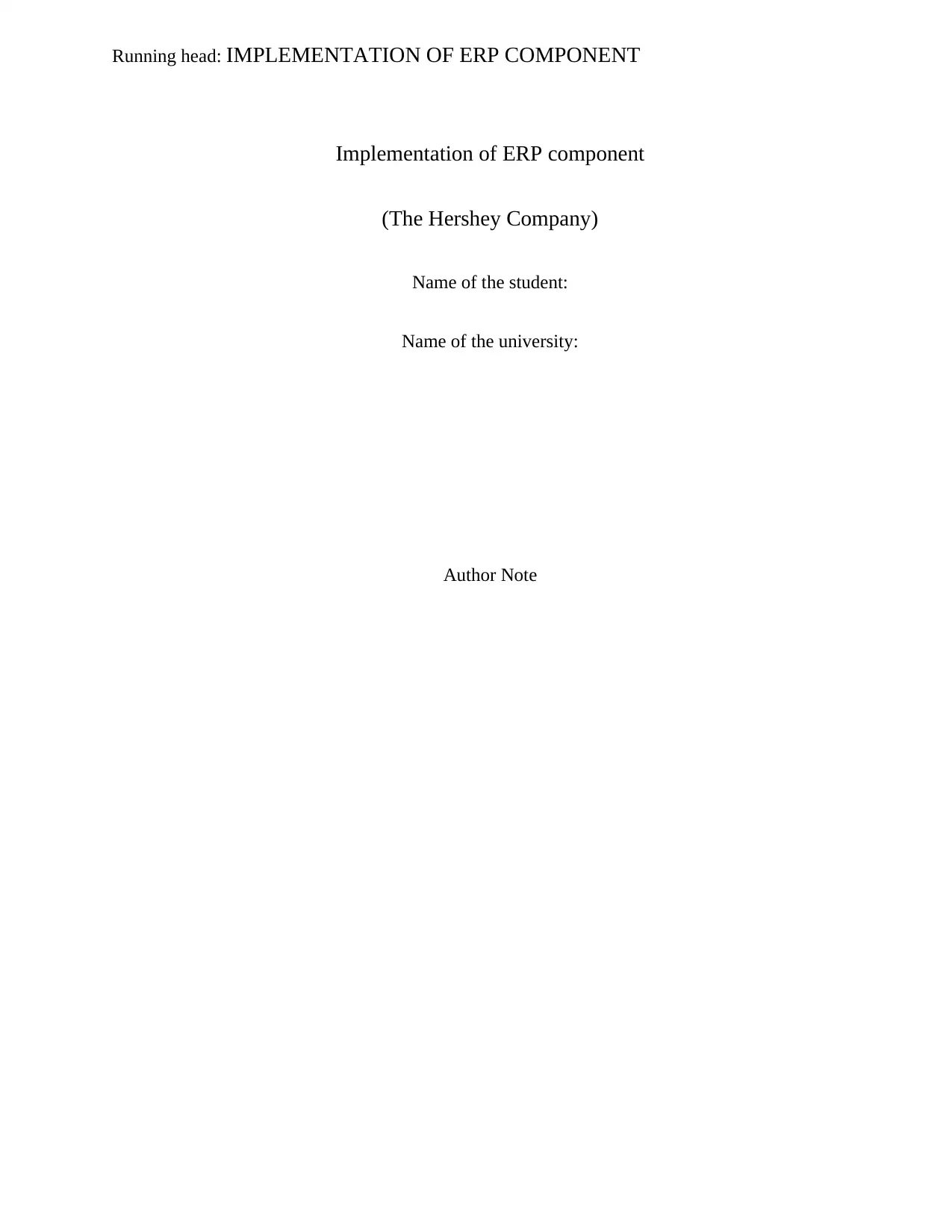
Running head: IMPLEMENTATION OF ERP COMPONENT
Implementation of ERP component
(The Hershey Company)
Name of the student:
Name of the university:
Author Note
Implementation of ERP component
(The Hershey Company)
Name of the student:
Name of the university:
Author Note
Paraphrase This Document
Need a fresh take? Get an instant paraphrase of this document with our AI Paraphraser
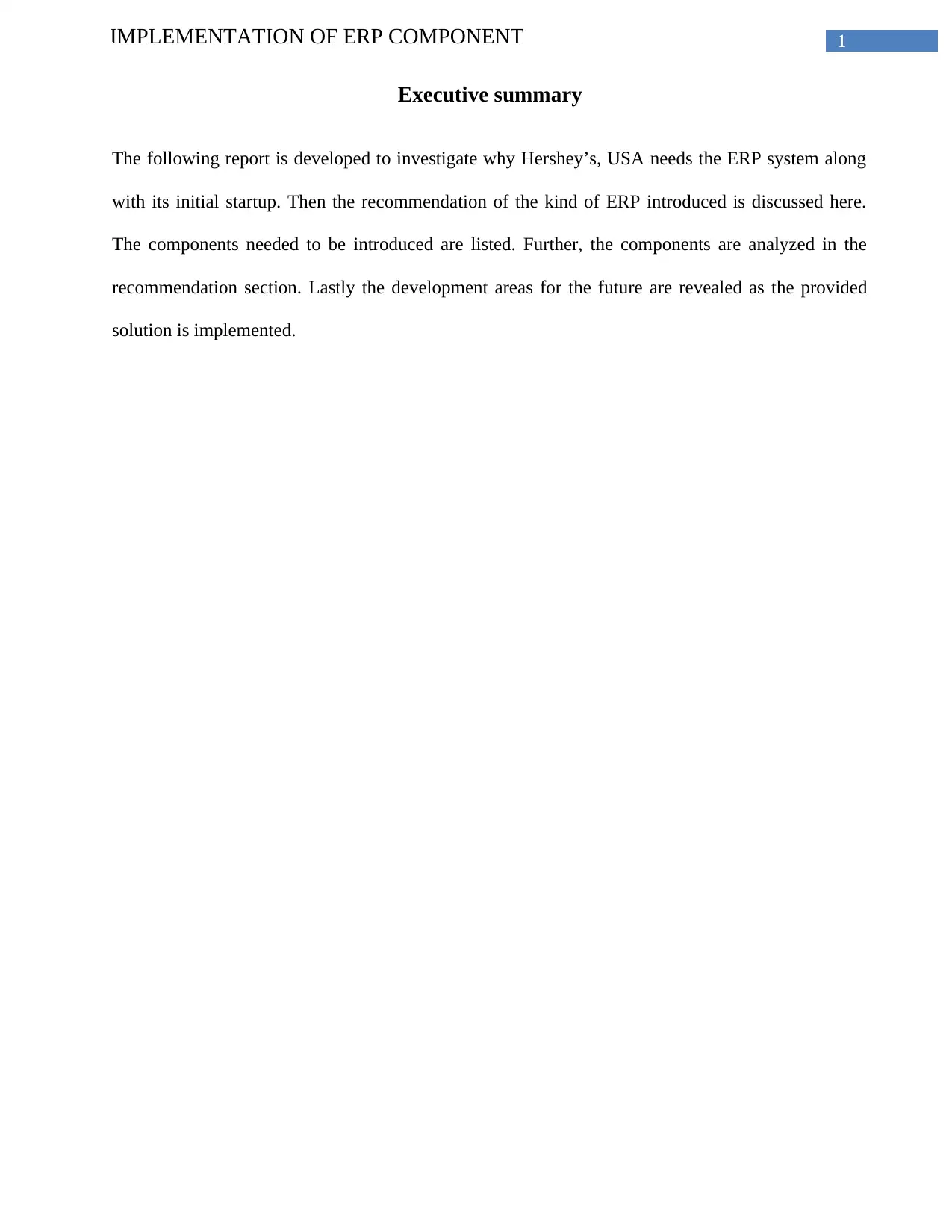
1IMPLEMENTATION OF ERP COMPONENT
Executive summary
The following report is developed to investigate why Hershey’s, USA needs the ERP system along
with its initial startup. Then the recommendation of the kind of ERP introduced is discussed here.
The components needed to be introduced are listed. Further, the components are analyzed in the
recommendation section. Lastly the development areas for the future are revealed as the provided
solution is implemented.
Executive summary
The following report is developed to investigate why Hershey’s, USA needs the ERP system along
with its initial startup. Then the recommendation of the kind of ERP introduced is discussed here.
The components needed to be introduced are listed. Further, the components are analyzed in the
recommendation section. Lastly the development areas for the future are revealed as the provided
solution is implemented.

2IMPLEMENTATION OF ERP COMPONENT
Table of Contents
1. Introduction:......................................................................................................................................3
2. Analysis of the business process of Hershey’s, necessity of ERP system and the initial startup:.....3
3. Developing the recommendation of the kind of ERP to be introduced at Hershey’s:.......................5
4. Listing the components to be introduced along with the reasons:.....................................................6
5. Describing the components in the recommendation:.........................................................................7
6. Implementation plan for Hershey’s:..................................................................................................8
7. Conclusion:........................................................................................................................................9
8. Recommendation of future development as the solution is implemented:........................................9
9. References:......................................................................................................................................11
Table of Contents
1. Introduction:......................................................................................................................................3
2. Analysis of the business process of Hershey’s, necessity of ERP system and the initial startup:.....3
3. Developing the recommendation of the kind of ERP to be introduced at Hershey’s:.......................5
4. Listing the components to be introduced along with the reasons:.....................................................6
5. Describing the components in the recommendation:.........................................................................7
6. Implementation plan for Hershey’s:..................................................................................................8
7. Conclusion:........................................................................................................................................9
8. Recommendation of future development as the solution is implemented:........................................9
9. References:......................................................................................................................................11
⊘ This is a preview!⊘
Do you want full access?
Subscribe today to unlock all pages.

Trusted by 1+ million students worldwide
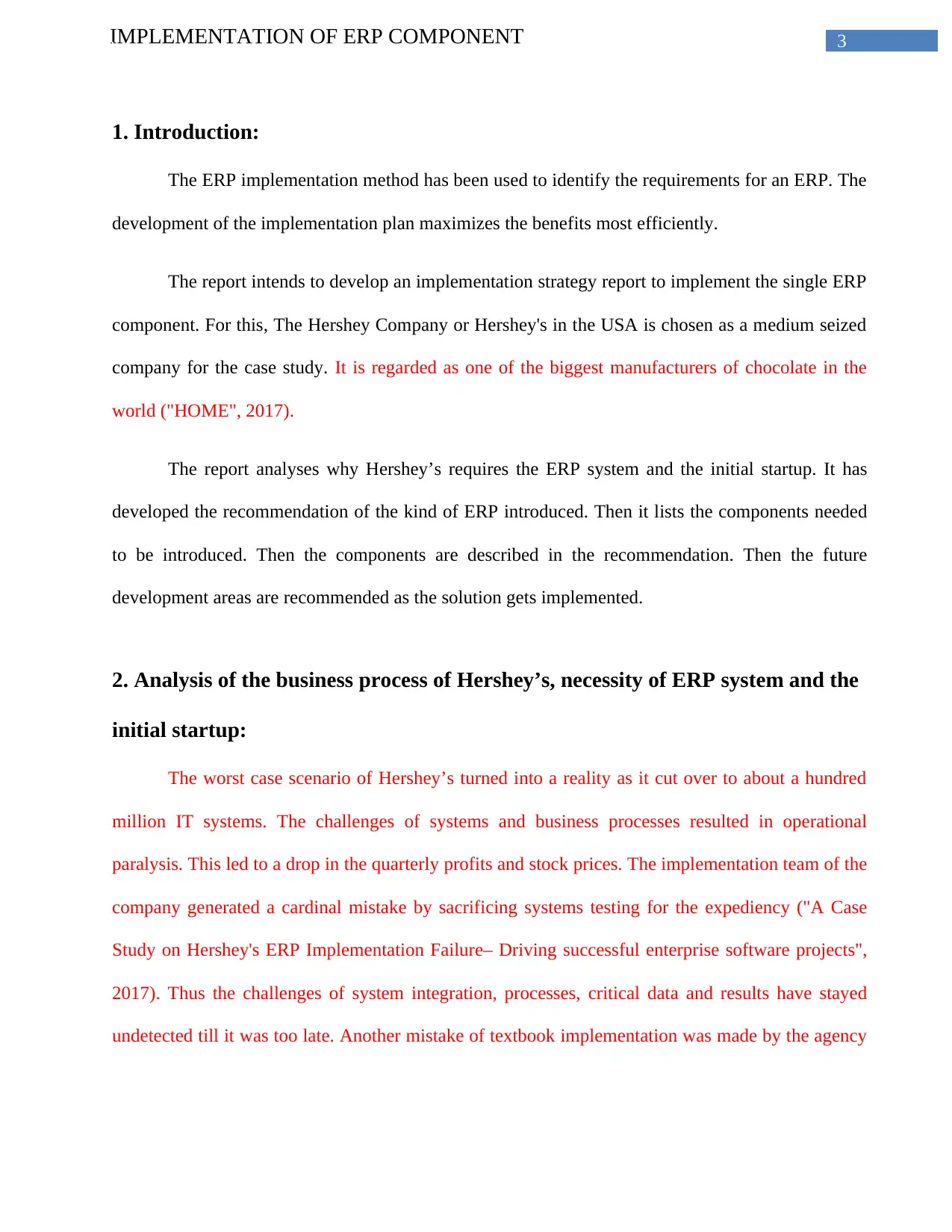
3IMPLEMENTATION OF ERP COMPONENT
1. Introduction:
The ERP implementation method has been used to identify the requirements for an ERP. The
development of the implementation plan maximizes the benefits most efficiently.
The report intends to develop an implementation strategy report to implement the single ERP
component. For this, The Hershey Company or Hershey's in the USA is chosen as a medium seized
company for the case study. It is regarded as one of the biggest manufacturers of chocolate in the
world ("HOME", 2017).
The report analyses why Hershey’s requires the ERP system and the initial startup. It has
developed the recommendation of the kind of ERP introduced. Then it lists the components needed
to be introduced. Then the components are described in the recommendation. Then the future
development areas are recommended as the solution gets implemented.
2. Analysis of the business process of Hershey’s, necessity of ERP system and the
initial startup:
The worst case scenario of Hershey’s turned into a reality as it cut over to about a hundred
million IT systems. The challenges of systems and business processes resulted in operational
paralysis. This led to a drop in the quarterly profits and stock prices. The implementation team of the
company generated a cardinal mistake by sacrificing systems testing for the expediency ("A Case
Study on Hershey's ERP Implementation Failure– Driving successful enterprise software projects",
2017). Thus the challenges of system integration, processes, critical data and results have stayed
undetected till it was too late. Another mistake of textbook implementation was made by the agency
1. Introduction:
The ERP implementation method has been used to identify the requirements for an ERP. The
development of the implementation plan maximizes the benefits most efficiently.
The report intends to develop an implementation strategy report to implement the single ERP
component. For this, The Hershey Company or Hershey's in the USA is chosen as a medium seized
company for the case study. It is regarded as one of the biggest manufacturers of chocolate in the
world ("HOME", 2017).
The report analyses why Hershey’s requires the ERP system and the initial startup. It has
developed the recommendation of the kind of ERP introduced. Then it lists the components needed
to be introduced. Then the components are described in the recommendation. Then the future
development areas are recommended as the solution gets implemented.
2. Analysis of the business process of Hershey’s, necessity of ERP system and the
initial startup:
The worst case scenario of Hershey’s turned into a reality as it cut over to about a hundred
million IT systems. The challenges of systems and business processes resulted in operational
paralysis. This led to a drop in the quarterly profits and stock prices. The implementation team of the
company generated a cardinal mistake by sacrificing systems testing for the expediency ("A Case
Study on Hershey's ERP Implementation Failure– Driving successful enterprise software projects",
2017). Thus the challenges of system integration, processes, critical data and results have stayed
undetected till it was too late. Another mistake of textbook implementation was made by the agency
Paraphrase This Document
Need a fresh take? Get an instant paraphrase of this document with our AI Paraphraser
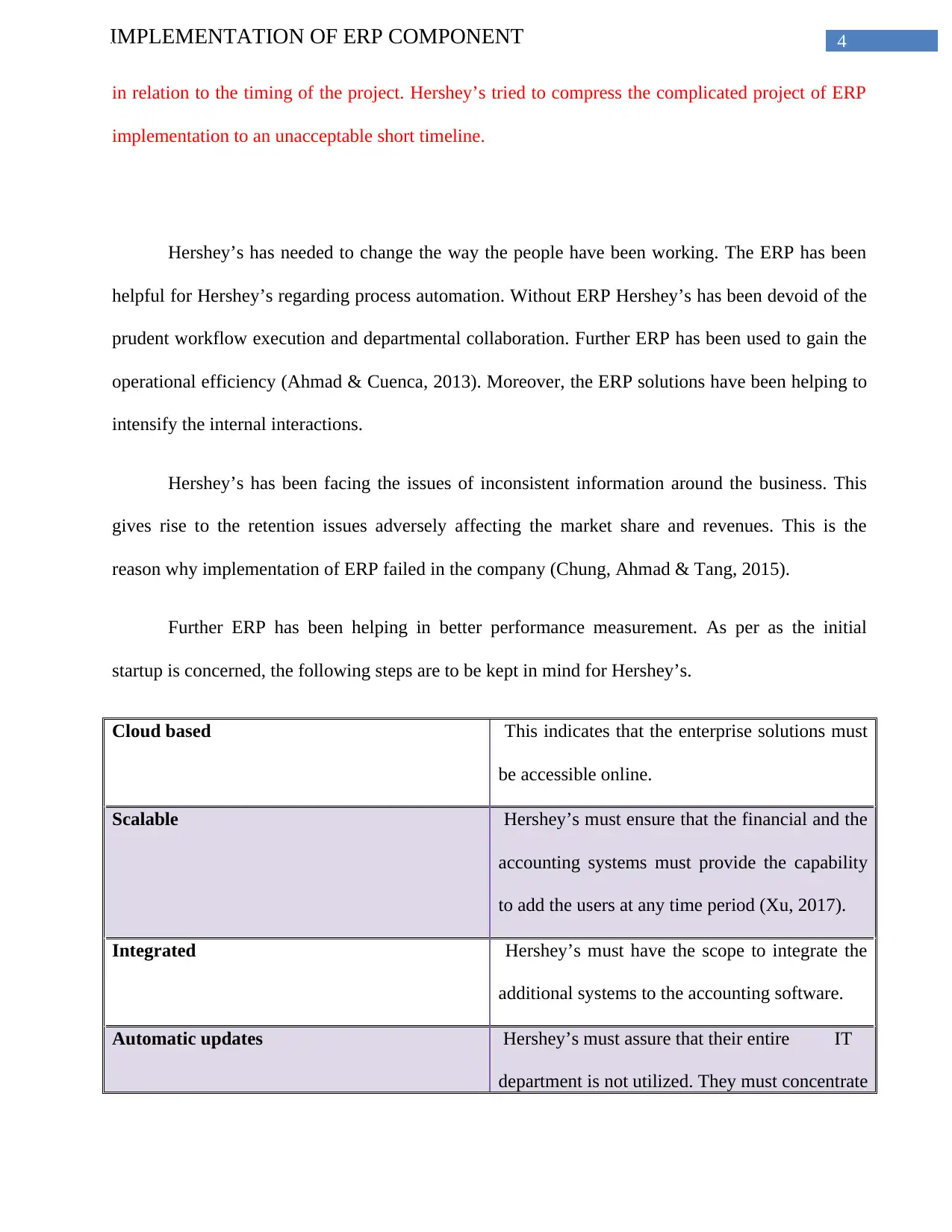
4IMPLEMENTATION OF ERP COMPONENT
in relation to the timing of the project. Hershey’s tried to compress the complicated project of ERP
implementation to an unacceptable short timeline.
Hershey’s has needed to change the way the people have been working. The ERP has been
helpful for Hershey’s regarding process automation. Without ERP Hershey’s has been devoid of the
prudent workflow execution and departmental collaboration. Further ERP has been used to gain the
operational efficiency (Ahmad & Cuenca, 2013). Moreover, the ERP solutions have been helping to
intensify the internal interactions.
Hershey’s has been facing the issues of inconsistent information around the business. This
gives rise to the retention issues adversely affecting the market share and revenues. This is the
reason why implementation of ERP failed in the company (Chung, Ahmad & Tang, 2015).
Further ERP has been helping in better performance measurement. As per as the initial
startup is concerned, the following steps are to be kept in mind for Hershey’s.
Cloud based This indicates that the enterprise solutions must
be accessible online.
Scalable Hershey’s must ensure that the financial and the
accounting systems must provide the capability
to add the users at any time period (Xu, 2017).
Integrated Hershey’s must have the scope to integrate the
additional systems to the accounting software.
Automatic updates Hershey’s must assure that their entire IT
department is not utilized. They must concentrate
in relation to the timing of the project. Hershey’s tried to compress the complicated project of ERP
implementation to an unacceptable short timeline.
Hershey’s has needed to change the way the people have been working. The ERP has been
helpful for Hershey’s regarding process automation. Without ERP Hershey’s has been devoid of the
prudent workflow execution and departmental collaboration. Further ERP has been used to gain the
operational efficiency (Ahmad & Cuenca, 2013). Moreover, the ERP solutions have been helping to
intensify the internal interactions.
Hershey’s has been facing the issues of inconsistent information around the business. This
gives rise to the retention issues adversely affecting the market share and revenues. This is the
reason why implementation of ERP failed in the company (Chung, Ahmad & Tang, 2015).
Further ERP has been helping in better performance measurement. As per as the initial
startup is concerned, the following steps are to be kept in mind for Hershey’s.
Cloud based This indicates that the enterprise solutions must
be accessible online.
Scalable Hershey’s must ensure that the financial and the
accounting systems must provide the capability
to add the users at any time period (Xu, 2017).
Integrated Hershey’s must have the scope to integrate the
additional systems to the accounting software.
Automatic updates Hershey’s must assure that their entire IT
department is not utilized. They must concentrate
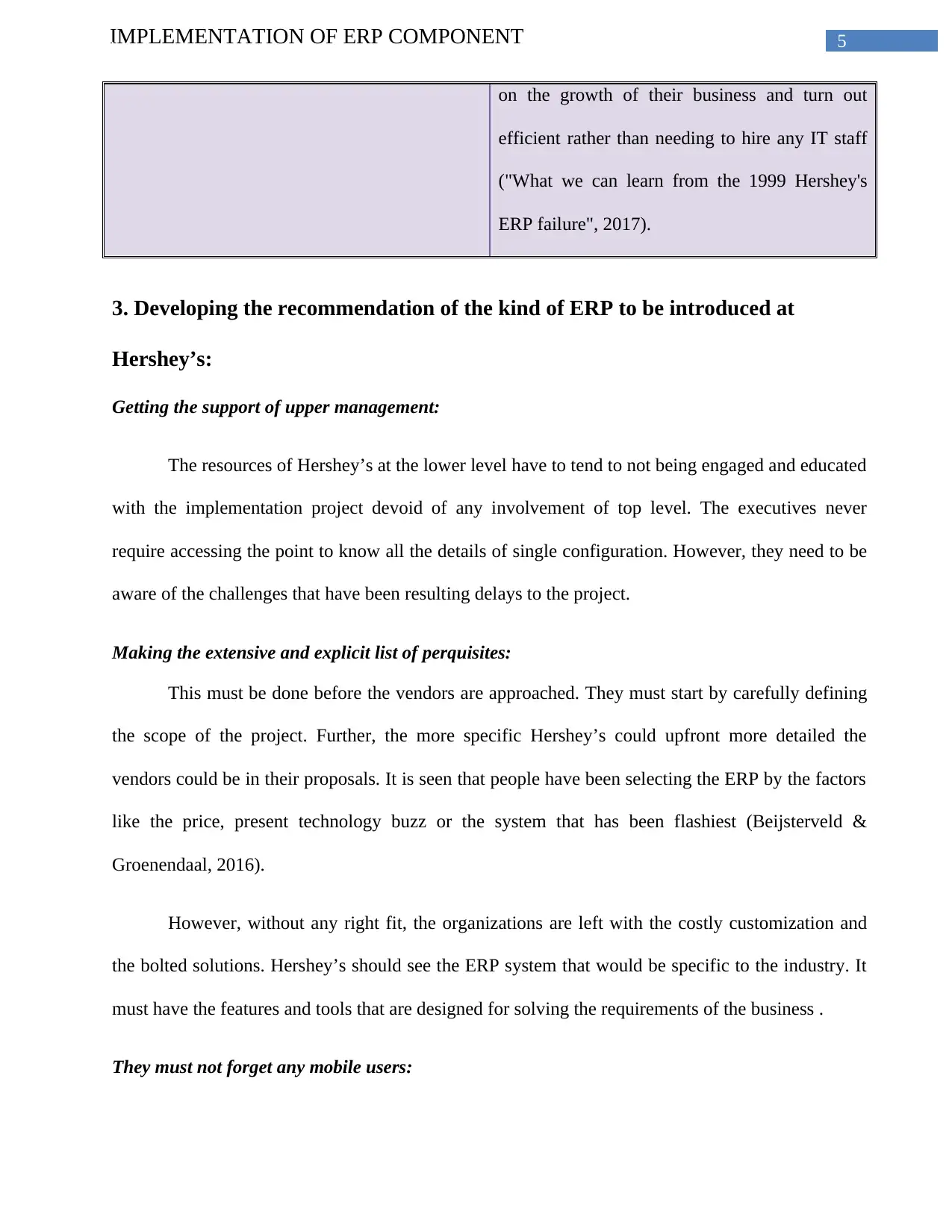
5IMPLEMENTATION OF ERP COMPONENT
on the growth of their business and turn out
efficient rather than needing to hire any IT staff
("What we can learn from the 1999 Hershey's
ERP failure", 2017).
3. Developing the recommendation of the kind of ERP to be introduced at
Hershey’s:
Getting the support of upper management:
The resources of Hershey’s at the lower level have to tend to not being engaged and educated
with the implementation project devoid of any involvement of top level. The executives never
require accessing the point to know all the details of single configuration. However, they need to be
aware of the challenges that have been resulting delays to the project.
Making the extensive and explicit list of perquisites:
This must be done before the vendors are approached. They must start by carefully defining
the scope of the project. Further, the more specific Hershey’s could upfront more detailed the
vendors could be in their proposals. It is seen that people have been selecting the ERP by the factors
like the price, present technology buzz or the system that has been flashiest (Beijsterveld &
Groenendaal, 2016).
However, without any right fit, the organizations are left with the costly customization and
the bolted solutions. Hershey’s should see the ERP system that would be specific to the industry. It
must have the features and tools that are designed for solving the requirements of the business .
They must not forget any mobile users:
on the growth of their business and turn out
efficient rather than needing to hire any IT staff
("What we can learn from the 1999 Hershey's
ERP failure", 2017).
3. Developing the recommendation of the kind of ERP to be introduced at
Hershey’s:
Getting the support of upper management:
The resources of Hershey’s at the lower level have to tend to not being engaged and educated
with the implementation project devoid of any involvement of top level. The executives never
require accessing the point to know all the details of single configuration. However, they need to be
aware of the challenges that have been resulting delays to the project.
Making the extensive and explicit list of perquisites:
This must be done before the vendors are approached. They must start by carefully defining
the scope of the project. Further, the more specific Hershey’s could upfront more detailed the
vendors could be in their proposals. It is seen that people have been selecting the ERP by the factors
like the price, present technology buzz or the system that has been flashiest (Beijsterveld &
Groenendaal, 2016).
However, without any right fit, the organizations are left with the costly customization and
the bolted solutions. Hershey’s should see the ERP system that would be specific to the industry. It
must have the features and tools that are designed for solving the requirements of the business .
They must not forget any mobile users:
⊘ This is a preview!⊘
Do you want full access?
Subscribe today to unlock all pages.

Trusted by 1+ million students worldwide
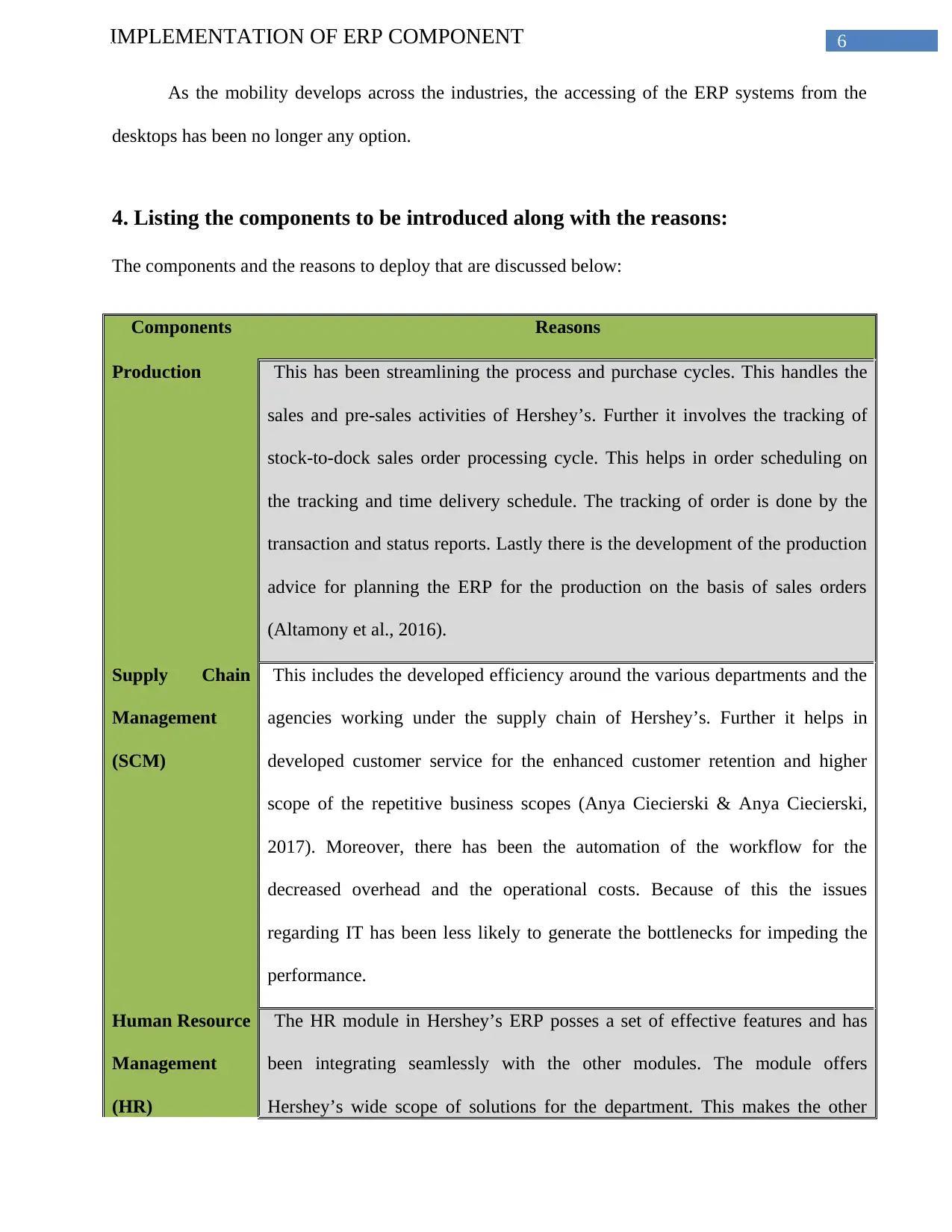
6IMPLEMENTATION OF ERP COMPONENT
As the mobility develops across the industries, the accessing of the ERP systems from the
desktops has been no longer any option.
4. Listing the components to be introduced along with the reasons:
The components and the reasons to deploy that are discussed below:
Components Reasons
Production This has been streamlining the process and purchase cycles. This handles the
sales and pre-sales activities of Hershey’s. Further it involves the tracking of
stock-to-dock sales order processing cycle. This helps in order scheduling on
the tracking and time delivery schedule. The tracking of order is done by the
transaction and status reports. Lastly there is the development of the production
advice for planning the ERP for the production on the basis of sales orders
(Altamony et al., 2016).
Supply Chain
Management
(SCM)
This includes the developed efficiency around the various departments and the
agencies working under the supply chain of Hershey’s. Further it helps in
developed customer service for the enhanced customer retention and higher
scope of the repetitive business scopes (Anya Ciecierski & Anya Ciecierski,
2017). Moreover, there has been the automation of the workflow for the
decreased overhead and the operational costs. Because of this the issues
regarding IT has been less likely to generate the bottlenecks for impeding the
performance.
Human Resource
Management
(HR)
The HR module in Hershey’s ERP posses a set of effective features and has
been integrating seamlessly with the other modules. The module offers
Hershey’s wide scope of solutions for the department. This makes the other
As the mobility develops across the industries, the accessing of the ERP systems from the
desktops has been no longer any option.
4. Listing the components to be introduced along with the reasons:
The components and the reasons to deploy that are discussed below:
Components Reasons
Production This has been streamlining the process and purchase cycles. This handles the
sales and pre-sales activities of Hershey’s. Further it involves the tracking of
stock-to-dock sales order processing cycle. This helps in order scheduling on
the tracking and time delivery schedule. The tracking of order is done by the
transaction and status reports. Lastly there is the development of the production
advice for planning the ERP for the production on the basis of sales orders
(Altamony et al., 2016).
Supply Chain
Management
(SCM)
This includes the developed efficiency around the various departments and the
agencies working under the supply chain of Hershey’s. Further it helps in
developed customer service for the enhanced customer retention and higher
scope of the repetitive business scopes (Anya Ciecierski & Anya Ciecierski,
2017). Moreover, there has been the automation of the workflow for the
decreased overhead and the operational costs. Because of this the issues
regarding IT has been less likely to generate the bottlenecks for impeding the
performance.
Human Resource
Management
(HR)
The HR module in Hershey’s ERP posses a set of effective features and has
been integrating seamlessly with the other modules. The module offers
Hershey’s wide scope of solutions for the department. This makes the other
Paraphrase This Document
Need a fresh take? Get an instant paraphrase of this document with our AI Paraphraser
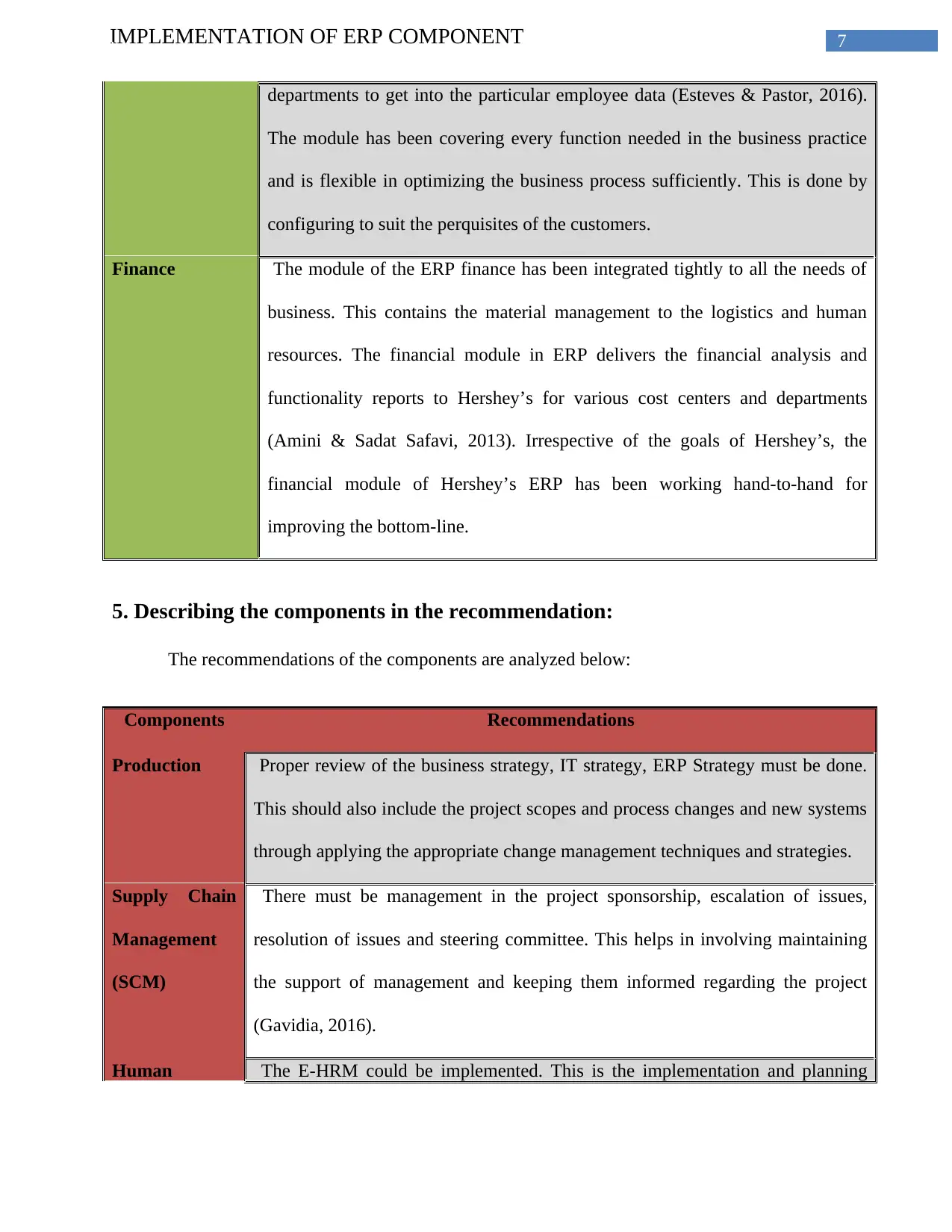
7IMPLEMENTATION OF ERP COMPONENT
departments to get into the particular employee data (Esteves & Pastor, 2016).
The module has been covering every function needed in the business practice
and is flexible in optimizing the business process sufficiently. This is done by
configuring to suit the perquisites of the customers.
Finance The module of the ERP finance has been integrated tightly to all the needs of
business. This contains the material management to the logistics and human
resources. The financial module in ERP delivers the financial analysis and
functionality reports to Hershey’s for various cost centers and departments
(Amini & Sadat Safavi, 2013). Irrespective of the goals of Hershey’s, the
financial module of Hershey’s ERP has been working hand-to-hand for
improving the bottom-line.
5. Describing the components in the recommendation:
The recommendations of the components are analyzed below:
Components Recommendations
Production Proper review of the business strategy, IT strategy, ERP Strategy must be done.
This should also include the project scopes and process changes and new systems
through applying the appropriate change management techniques and strategies.
Supply Chain
Management
(SCM)
There must be management in the project sponsorship, escalation of issues,
resolution of issues and steering committee. This helps in involving maintaining
the support of management and keeping them informed regarding the project
(Gavidia, 2016).
Human The E-HRM could be implemented. This is the implementation and planning
departments to get into the particular employee data (Esteves & Pastor, 2016).
The module has been covering every function needed in the business practice
and is flexible in optimizing the business process sufficiently. This is done by
configuring to suit the perquisites of the customers.
Finance The module of the ERP finance has been integrated tightly to all the needs of
business. This contains the material management to the logistics and human
resources. The financial module in ERP delivers the financial analysis and
functionality reports to Hershey’s for various cost centers and departments
(Amini & Sadat Safavi, 2013). Irrespective of the goals of Hershey’s, the
financial module of Hershey’s ERP has been working hand-to-hand for
improving the bottom-line.
5. Describing the components in the recommendation:
The recommendations of the components are analyzed below:
Components Recommendations
Production Proper review of the business strategy, IT strategy, ERP Strategy must be done.
This should also include the project scopes and process changes and new systems
through applying the appropriate change management techniques and strategies.
Supply Chain
Management
(SCM)
There must be management in the project sponsorship, escalation of issues,
resolution of issues and steering committee. This helps in involving maintaining
the support of management and keeping them informed regarding the project
(Gavidia, 2016).
Human The E-HRM could be implemented. This is the implementation and planning
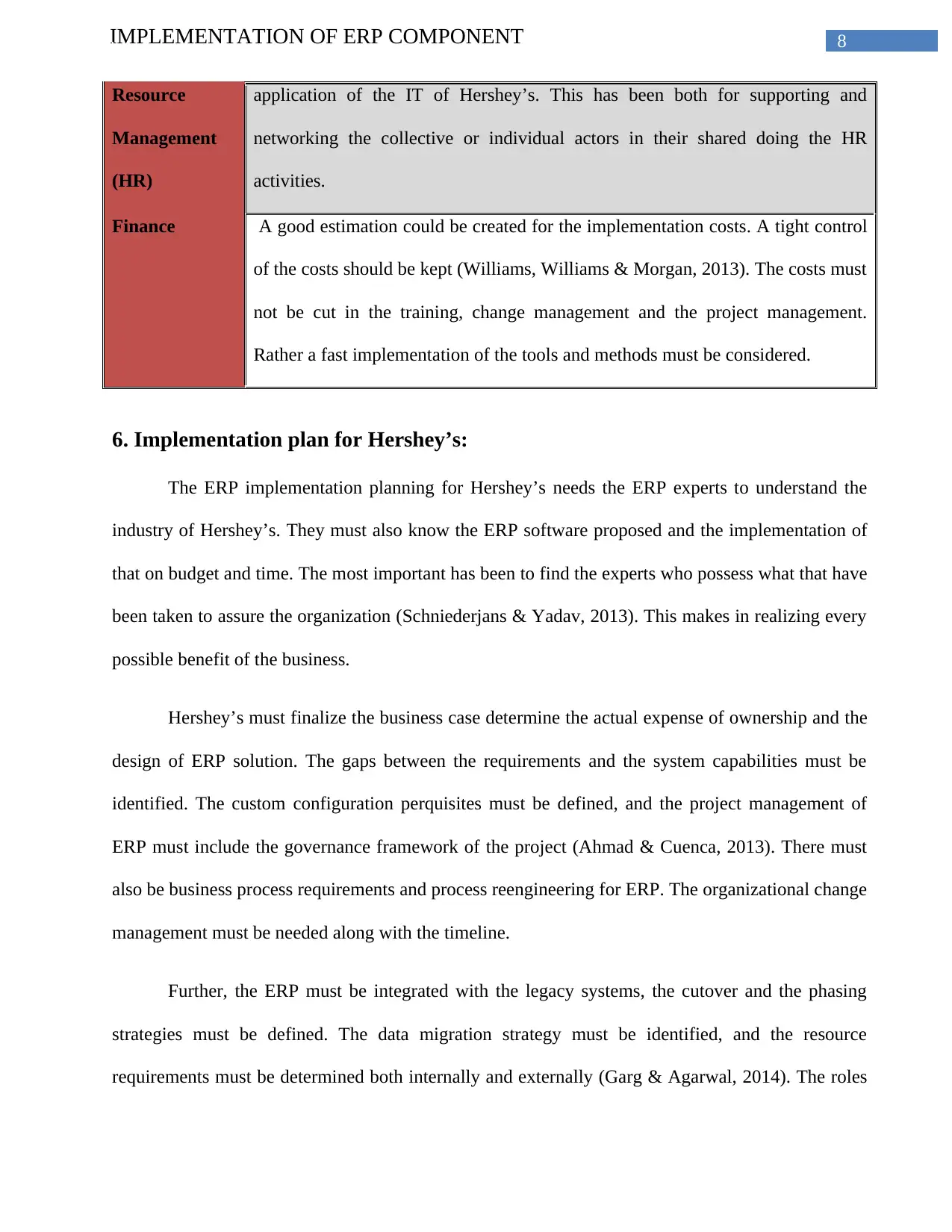
8IMPLEMENTATION OF ERP COMPONENT
Resource
Management
(HR)
application of the IT of Hershey’s. This has been both for supporting and
networking the collective or individual actors in their shared doing the HR
activities.
Finance A good estimation could be created for the implementation costs. A tight control
of the costs should be kept (Williams, Williams & Morgan, 2013). The costs must
not be cut in the training, change management and the project management.
Rather a fast implementation of the tools and methods must be considered.
6. Implementation plan for Hershey’s:
The ERP implementation planning for Hershey’s needs the ERP experts to understand the
industry of Hershey’s. They must also know the ERP software proposed and the implementation of
that on budget and time. The most important has been to find the experts who possess what that have
been taken to assure the organization (Schniederjans & Yadav, 2013). This makes in realizing every
possible benefit of the business.
Hershey’s must finalize the business case determine the actual expense of ownership and the
design of ERP solution. The gaps between the requirements and the system capabilities must be
identified. The custom configuration perquisites must be defined, and the project management of
ERP must include the governance framework of the project (Ahmad & Cuenca, 2013). There must
also be business process requirements and process reengineering for ERP. The organizational change
management must be needed along with the timeline.
Further, the ERP must be integrated with the legacy systems, the cutover and the phasing
strategies must be defined. The data migration strategy must be identified, and the resource
requirements must be determined both internally and externally (Garg & Agarwal, 2014). The roles
Resource
Management
(HR)
application of the IT of Hershey’s. This has been both for supporting and
networking the collective or individual actors in their shared doing the HR
activities.
Finance A good estimation could be created for the implementation costs. A tight control
of the costs should be kept (Williams, Williams & Morgan, 2013). The costs must
not be cut in the training, change management and the project management.
Rather a fast implementation of the tools and methods must be considered.
6. Implementation plan for Hershey’s:
The ERP implementation planning for Hershey’s needs the ERP experts to understand the
industry of Hershey’s. They must also know the ERP software proposed and the implementation of
that on budget and time. The most important has been to find the experts who possess what that have
been taken to assure the organization (Schniederjans & Yadav, 2013). This makes in realizing every
possible benefit of the business.
Hershey’s must finalize the business case determine the actual expense of ownership and the
design of ERP solution. The gaps between the requirements and the system capabilities must be
identified. The custom configuration perquisites must be defined, and the project management of
ERP must include the governance framework of the project (Ahmad & Cuenca, 2013). There must
also be business process requirements and process reengineering for ERP. The organizational change
management must be needed along with the timeline.
Further, the ERP must be integrated with the legacy systems, the cutover and the phasing
strategies must be defined. The data migration strategy must be identified, and the resource
requirements must be determined both internally and externally (Garg & Agarwal, 2014). The roles
⊘ This is a preview!⊘
Do you want full access?
Subscribe today to unlock all pages.

Trusted by 1+ million students worldwide
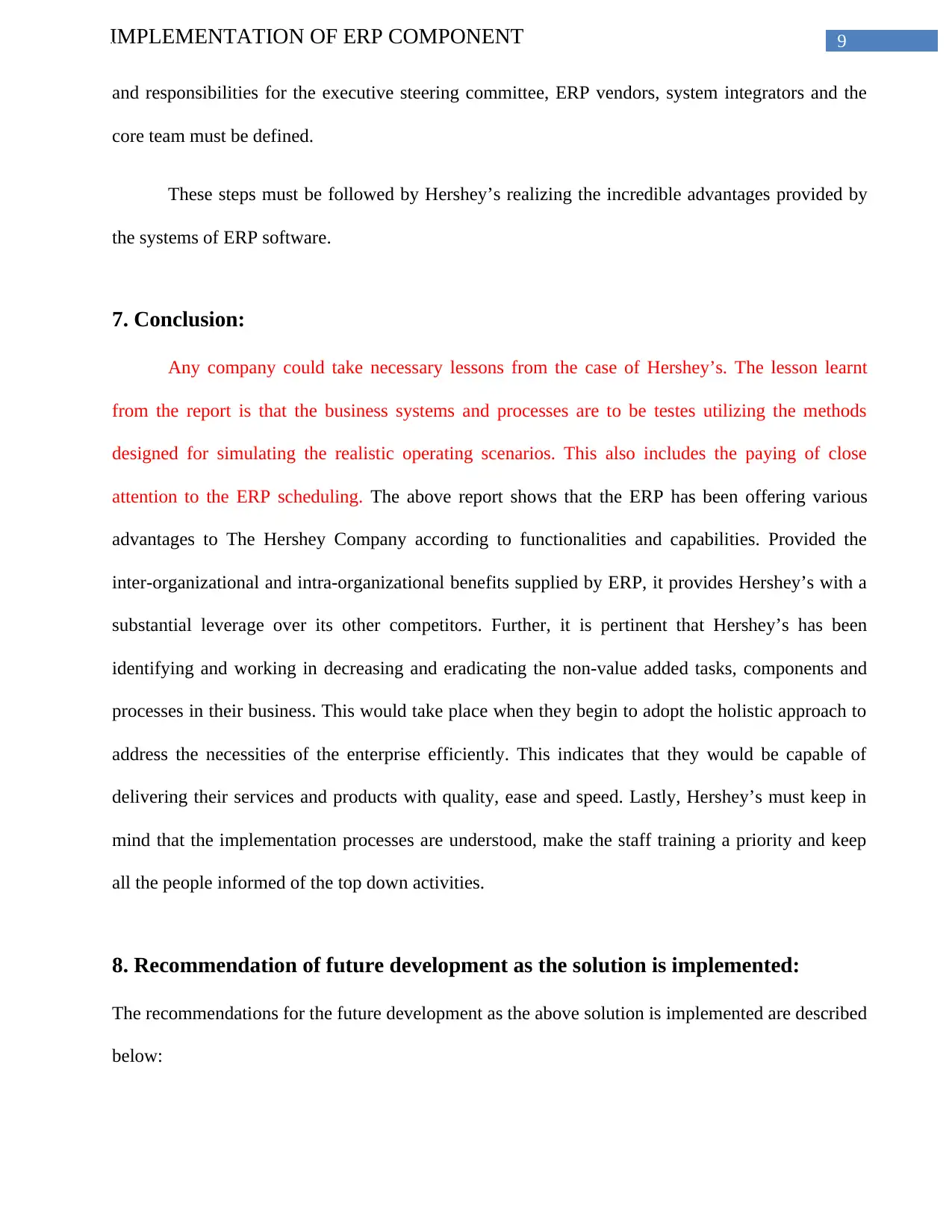
9IMPLEMENTATION OF ERP COMPONENT
and responsibilities for the executive steering committee, ERP vendors, system integrators and the
core team must be defined.
These steps must be followed by Hershey’s realizing the incredible advantages provided by
the systems of ERP software.
7. Conclusion:
Any company could take necessary lessons from the case of Hershey’s. The lesson learnt
from the report is that the business systems and processes are to be testes utilizing the methods
designed for simulating the realistic operating scenarios. This also includes the paying of close
attention to the ERP scheduling. The above report shows that the ERP has been offering various
advantages to The Hershey Company according to functionalities and capabilities. Provided the
inter-organizational and intra-organizational benefits supplied by ERP, it provides Hershey’s with a
substantial leverage over its other competitors. Further, it is pertinent that Hershey’s has been
identifying and working in decreasing and eradicating the non-value added tasks, components and
processes in their business. This would take place when they begin to adopt the holistic approach to
address the necessities of the enterprise efficiently. This indicates that they would be capable of
delivering their services and products with quality, ease and speed. Lastly, Hershey’s must keep in
mind that the implementation processes are understood, make the staff training a priority and keep
all the people informed of the top down activities.
8. Recommendation of future development as the solution is implemented:
The recommendations for the future development as the above solution is implemented are described
below:
and responsibilities for the executive steering committee, ERP vendors, system integrators and the
core team must be defined.
These steps must be followed by Hershey’s realizing the incredible advantages provided by
the systems of ERP software.
7. Conclusion:
Any company could take necessary lessons from the case of Hershey’s. The lesson learnt
from the report is that the business systems and processes are to be testes utilizing the methods
designed for simulating the realistic operating scenarios. This also includes the paying of close
attention to the ERP scheduling. The above report shows that the ERP has been offering various
advantages to The Hershey Company according to functionalities and capabilities. Provided the
inter-organizational and intra-organizational benefits supplied by ERP, it provides Hershey’s with a
substantial leverage over its other competitors. Further, it is pertinent that Hershey’s has been
identifying and working in decreasing and eradicating the non-value added tasks, components and
processes in their business. This would take place when they begin to adopt the holistic approach to
address the necessities of the enterprise efficiently. This indicates that they would be capable of
delivering their services and products with quality, ease and speed. Lastly, Hershey’s must keep in
mind that the implementation processes are understood, make the staff training a priority and keep
all the people informed of the top down activities.
8. Recommendation of future development as the solution is implemented:
The recommendations for the future development as the above solution is implemented are described
below:
Paraphrase This Document
Need a fresh take? Get an instant paraphrase of this document with our AI Paraphraser

10IMPLEMENTATION OF ERP COMPONENT
Integrated with Big data:
The ERP solutions must be integrated with the Big data and particularly the wider datasets.
Analysis of data:
The ERP is analyzing and looking the data is silos of the business data. It should not ignore
the data from the external world.
The merging of the massive data sets on the social behavior:
This fusion of the datasets in the social acts like Twitter, Facebook and datasets to the
various data of the ERP systems could revolutionize the way in which Hershey’s business might take
decisions.
The collection of the requirements of business:
The selection of the business perquisites has been aiming to the development of solutions.
This has been supporting the activity of the end-customers.
Integrated with Big data:
The ERP solutions must be integrated with the Big data and particularly the wider datasets.
Analysis of data:
The ERP is analyzing and looking the data is silos of the business data. It should not ignore
the data from the external world.
The merging of the massive data sets on the social behavior:
This fusion of the datasets in the social acts like Twitter, Facebook and datasets to the
various data of the ERP systems could revolutionize the way in which Hershey’s business might take
decisions.
The collection of the requirements of business:
The selection of the business perquisites has been aiming to the development of solutions.
This has been supporting the activity of the end-customers.

11IMPLEMENTATION OF ERP COMPONENT
9. References:
A Case Study on Hershey's ERP Implementation Failure– Driving successful enterprise software
projects. (2017). Pemeco.com. Retrieved 17 November 2017, from
https://www.pemeco.com/a-case-study-on-hersheys-erp-implementation-failure-the-
importance-of-testing-and-scheduling/
Ahmad, M. M., & Cuenca, R. P. (2013). Critical success factors for ERP implementation in
SMEs. Robotics and Computer-Integrated Manufacturing, 29(3), 104-111.
Ahmad, M. M., & Cuenca, R. P. (2013). Critical success factors for ERP implementation in
SMEs. Robotics and Computer-Integrated Manufacturing, 29(3), 104-111.
Altamony, H., Tarhini, A., Al-Salti, Z., Gharaibeh, A., & Elyas, T. (2016). The relationship between
change management strategy and successful enterprise resource planning (ERP)
implementations: A theoretical perspective. International Journal of Business Management
and Economic Research, 7(4), 690-703.
Amini, M., & Sadat Safavi, N. (2013). critical success factors for ERP implementation.
Anya Ciecierski, C., & Anya Ciecierski, C. (2017). A Lesson Learned from Hershey’s Failed ERP
Implementation - ERP Cloud Software. ERP Cloud Software. Retrieved 17 November 2017,
from http://erpsoftwareblog.com/cloud/2015/03/a-lesson-learned-from-hersheys-failed-erp-
implementation/
Beijsterveld, J. A., & Groenendaal, W. J. (2016). Solving misfits in ERP implementations by
SMEs. Information Systems Journal, 26(4), 369-393.
9. References:
A Case Study on Hershey's ERP Implementation Failure– Driving successful enterprise software
projects. (2017). Pemeco.com. Retrieved 17 November 2017, from
https://www.pemeco.com/a-case-study-on-hersheys-erp-implementation-failure-the-
importance-of-testing-and-scheduling/
Ahmad, M. M., & Cuenca, R. P. (2013). Critical success factors for ERP implementation in
SMEs. Robotics and Computer-Integrated Manufacturing, 29(3), 104-111.
Ahmad, M. M., & Cuenca, R. P. (2013). Critical success factors for ERP implementation in
SMEs. Robotics and Computer-Integrated Manufacturing, 29(3), 104-111.
Altamony, H., Tarhini, A., Al-Salti, Z., Gharaibeh, A., & Elyas, T. (2016). The relationship between
change management strategy and successful enterprise resource planning (ERP)
implementations: A theoretical perspective. International Journal of Business Management
and Economic Research, 7(4), 690-703.
Amini, M., & Sadat Safavi, N. (2013). critical success factors for ERP implementation.
Anya Ciecierski, C., & Anya Ciecierski, C. (2017). A Lesson Learned from Hershey’s Failed ERP
Implementation - ERP Cloud Software. ERP Cloud Software. Retrieved 17 November 2017,
from http://erpsoftwareblog.com/cloud/2015/03/a-lesson-learned-from-hersheys-failed-erp-
implementation/
Beijsterveld, J. A., & Groenendaal, W. J. (2016). Solving misfits in ERP implementations by
SMEs. Information Systems Journal, 26(4), 369-393.
⊘ This is a preview!⊘
Do you want full access?
Subscribe today to unlock all pages.

Trusted by 1+ million students worldwide
1 out of 13
Related Documents
Your All-in-One AI-Powered Toolkit for Academic Success.
+13062052269
info@desklib.com
Available 24*7 on WhatsApp / Email
![[object Object]](/_next/static/media/star-bottom.7253800d.svg)
Unlock your academic potential
Copyright © 2020–2025 A2Z Services. All Rights Reserved. Developed and managed by ZUCOL.





